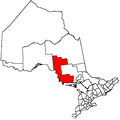Missanabie
Missanabie | |
|---|---|
Unincorporated community | |
| Coordinates: 48°18′41″N 84°05′02″W / 48.3114°N 84.0839°W | |
| Country | Canada |
| Province | Ontario |
| District | Algoma |
| Census subdiv. | Unorg. North Algoma |
| Founded | 1880s |
| Area | |
| • Land | 0.27 km2 (0.10 sq mi) |
| Elevation | 335 m (1,098 ft) |
| Population (2021)[1] | |
• Total | 33 |
| • Density | 121.3/km2 (314/sq mi) |
| Time zone | UTC-5 (EST) |
| • Summer (DST) | UTC-4 (EDT) |
| Postal code | P0M |
| Area code(s) | 705, 249 |
Missanabie is a community in the Canadian province of Ontario, located in the Algoma District at the northern terminus of Highway 651, inside the boundaries of the Chapleau Crown Game Preserve.
A designated place served by a local services board,[3] the community had a population of 33 in the 2021 Canadian census.[1]
Missanabie, located on the north end of Dog Lake,[4] caters to outdoor recreation and serves as the starting point for fishing/hunting trips and lodges in the area.
History

Missanabie was founded as a railroad town along the Canadian Pacific Railway that was completed in 1885. Its name is a corruption of Missinaibi.[5] In 1893, its post office opened.
In 1887, the Hudson's Bay Company established a fur trade post in Missanabie, opposite the station. Facing competition of several other companies, including Revillon Frères, it supplied the HBC New Brunswick post on Missinaibi Lake. After the completion of 2 more east-west railways through northern Ontario (the Canadian Northern Railway and the National Transcontinental Railway) in 1912, the inland HBC posts along the Missinaibi River were no longer needed, and the Missanabie post became more important as HBC's supply hub, taking over this role from Moose Factory. On June 1, 1938, the Missanabie post was closed and sold.[5]
Demographics
In the 2021 Census of Population conducted by Statistics Canada, Missanabie had a population of 33 living in 15 of its 38 total private dwellings, a change of -17.5% from its 2016 population of 40. With a land area of 0.27 km2 (0.10 sq mi), it had a population density of 122.2/km2 (316.6/sq mi) in 2021.[1]
| 2021 | 2016 | |
|---|---|---|
| Population | 33 (-17.5% from 2016) | 40 (+37.9% from 2011) |
| Land area | 0.27 km2 (0.10 sq mi) | 0.30 km2 (0.12 sq mi) |
| Population density | 121.3/km2 (314/sq mi) | 135.0/km2 (350/sq mi) |
| Median age | 47.0 (M: 44.0, F: 49.0) | |
| Private dwellings | 38 (total) 15 (occupied) | 38 (total) 16 (occupied) |
| Median household income |
| Year | Pop. | ±% |
|---|---|---|
| 2006 | 62 | — |
| 2011 | 29 | −53.2% |
| 2016 | 40 | +37.9% |
| 2021 | 33 | −17.5% |
| Source: Statistics Canada[1][8] | ||
References
- ^ a b c d e "Missanabie, Local service board (LSB) Ontario [Designated place] Census Profile, 2021 Census of Population". www12.statcan.gc.ca. Government of Canada - Statistics Canada. Retrieved 15 January 2024.
- ^ White, James (1915). Altitudes in the Dominion of Canada (2nd ed.). Ottawa: Commission of Conservation. p. 6.
- ^ Local Services Boards, R.R.O. 1990, Reg. 737 Archived 2014-03-10 at the Wayback Machine. Canadian Legal Information Institute.
- ^ "Dog Lake". Geographical Names Data Base. Natural Resources Canada. Retrieved 17 January 2025.
- ^ a b "Hudson's Bay Company: Missanabie". pam.minisisinc.com. Archives of Manitoba - Keystone Archives Descriptive Database. Retrieved 13 January 2025.
- ^ "2021 Community Profiles". 2021 Canadian census. Statistics Canada. February 4, 2022. Retrieved 2025-01-15.
- ^ "2016 Community Profiles". 2016 Canadian census. Statistics Canada. August 12, 2021. Retrieved 2025-01-15.
- ^ Population and dwelling counts, for Canada, provinces and territories, and designated places, 2006 and 2001 censuses


